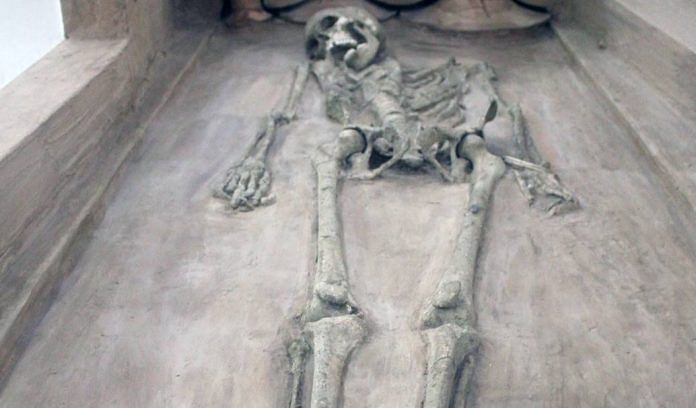Vasant Shinde says skeletons found in Rakhigarhi date to around 2500 BC, and there’s only ‘stray evidence’ of contact with Central Asians at that time.
New Delhi: The 4,500-year-old skeletons recovered from the cradle of the Harappan civilisation did not have the ‘Aryan gene’, but this does not necessarily bolster the contentious Aryan invasion theory, experts say.
“There isn’t any proof of a large-scale migration since at least 9,000 years,” archaeologist Vasant Shinde, who led the 2015 excavation in Rakhigarhi where the skeletons were found, told ThePrint.
“There is only stray evidence of contact with Central Asians around 2500 BC by virtue of trade,” he added.
Rakhigarhi, a village in Haryana’s Hisar district, was part of the Indus Valley civilisation, which lasted roughly two millennia between 3300 and 1300 BC. The skeletons found – dating back to around 2500 BC, classified as the ‘mature Harappan civilisation’ – were not found to have the R1a1 gene, loosely labeled the ‘Aryan gene’.
Also read: Does Rakhigarhi skeleton DNA confirm Dravidian ancestry or reignite Aryan invasion debate?
R1a1 genes are believed to originate from a population traced to the Central Asian ‘Pontic steppe’ some 4,000 years ago.
“Plenty of people believe the Aryans came from Central Asia. But we have no evidence of that,” Shinde said, “If they had migrated to India en masse, they would have imported their culture and traditions with them to our country — which is not the case at all.”
“We have evidence of contact with Iran and West Asia right from the beginning, for trading purposes,” Shinde said. “But, it never amplified because of any migration during or after the Harappan civilisation.”
“We did not find any central Asian ancestory in the DNA sample,” said Niraj Rai, the lead genetic researcher on the Rakhigarhi study.
“This suggests that the Rakhigarhi residents hadn’t mixed with the Central Asians till then,” he added. Unlike Shinde, however, he does not completely dismiss large-scale migration to India, saying such an influx is likely to have occurred around 1500 BC, which is a different time period from what the study focuses on.
According to Shinde, the “fallacious” conclusions drawn about their findings undermined their yet-to-be-published study.
He was referring to a recent media report and subsequent online discussions that suggested his team’s findings reinforced the Aryan invasion theory, a highly controversial argument.
A colonial legacy
The Aryan invasion theory is said to be the brainchild of India’s former colonial rulers, who peddled the idea that members of the country’s high castes were descendants of Aryan invaders from Central Asia who are also the forebears of the Europeans.
Some Hindu groups subsequently argued that Aryans were not invaders at all, but native to the land, and that these indigenous people developed Vedic Hinduism. The invasion theory proffers that Vedic Hinduism was developed by European migrants, and came after the Indus Valley civilisation.
Also read: Do the excavations of ancient stone tools in India reshape our theories of early human migration?
Shinde, however, said there was evidence to suggest the Harappan civilisation coincided with the writing of Hindu texts.
“Since there is a description of a civilisation very similar to the Harappan civilisation in the Vedic texts, there is a possibility of a strong link between the two,” he added, “They could have been contemporaries.”
Meanwhile, Ajith Prasad, who heads the department of archaeology at Baroda’s Maharaja Sayajirao University of Baroda, sought to dismiss the entire controversy by denying such a thing as an ‘Aryan gene’ existed.
“Aryan is such a vague term. There is nothing like ‘Aryan’ in archaeology,” he told ThePrint.
“It’s impossible to identify one set of genes and call it Aryan. The Rakhigarhi study doesn’t tell us anything about Aryan invasion,” he said, “All these conclusions are based on untested assumptions.”
Ancient links
Largely, two kinds of genes can be found in India: Ancestral north Indian (ANI) and ancestral south Indian (ASI). ANI is genetically closer to those from West and Central Asia, and Europeans. ASI, on the other hand, bears no evidence of mixing due to a complete absence of these steppe genes.
While the Rakhigarhi skeletons didn’t have the R1a1 gene, most modern-day Indians do. What explains that?
“We could have had increased contact with people from Central Asia. But there is very little evidence to show that they migrated in large numbers,” he said, “Perhaps the contact increased due to various other reasons.”







Very balanced article .
Thumbs up from me .
Academia places high importance on evidence, so both the early theories of Aryan invasion and Aryan Homeland in Indian subcontinent got rejected, right from the inception itself, irrespective of who came up with the theory.
No evidence of any wars, mass soldier graves or destruction of IVC (Harappan) towns has been found and no proof exists if IVC (Harappan) people were the ones that are referred in Vedas as Asuras or Dasyu or any other category of peoples whom Aryans defeated. So, Aryans never invaded, but arrived in small waves after 1500 BC into Indian subcontinent. Evidences have significantly increased to prove that IVC people began deserting towns after 2000 BC, migrating eastwards to interior forests of Gangetic belt and Gujarat/ Konkan coast due to centuries of monsoon failures and resultant drying of Ghaghar/Sarasvati and other river streams of Haryana, Rajasthan and Sind.
At the same time, Aryans are not originally from India and were definitely from Steppes (Caspian Sea / Urals / or higher up) as an ocean of evidence exists for that, including the simplest one – Sanskrit, Old Iranian and further upwards the Old European languages share most of their cognate words, and also because the
earliest ancient evidence of domestication and burial of horses, as mentioned in Vedas, are reported in large numbers in this region.
The major puzzle today, is in piecing where IVC people migrated into India, and which early communities’ script or artifacts can prove their linkage to the rich IVC heritage.